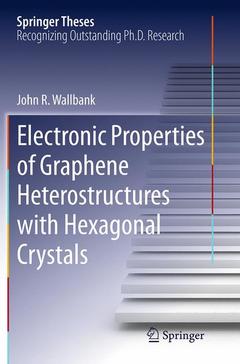Description
Electronic Properties of Graphene Heterostructures with Hexagonal Crystals, 2014
Springer Theses Series
Language: English
Subjects for Electronic Properties of Graphene Heterostructures with...:
Electronic Properties of Graphene Heterostructures with Hexagonal Crystals
Publication date: 09-2016
Support: Print on demand
Publication date: 09-2016
Support: Print on demand
Electronic Properties of Graphene Heterostructures with Hexagonal Crystals
Publication date: 07-2014
95 p. · 15.5x23.5 cm · Hardback
Publication date: 07-2014
95 p. · 15.5x23.5 cm · Hardback
Description
/li>Contents
/li>Comment
/li>
The last decade has witnessed the discovery of, and dramatic progress in understanding the physics of graphene and related two-dimensional materials. The development of methods for manufacturing and aligning high-quality two-dimensional crystals has facilitated the creation of a new generation of materials: the heterostructures of graphene with hexagonal crystals, in which the graphene electrons acquire new, qualitatively different properties. This thesis provides a comprehensive theoretical framework in which to understand these heterostructures, based on the tight binding model, perturbation theory, group theory and the concept of the moire superlattice (all of which are elucidated). It explains how graphene heterostructures provide new opportunities for tailoring band structure, such as creating additional Dirac points or opening band gaps and how they manifest themselves in transport measurements, optical absorption spectra and the fractal Hofstadter spectra. Also considered are the heterostructures of bilayer graphene and resonant tunneling in aligned graphene/insulator/graphene devices.
Monolayer Graphene on a hBN Underlay.- Optical Absorption in Graphene-hBN Heterostructures.- Fractal Spectrum of Magnetic Minibands in Graphene-hBN Heterostructures.- Experimental Realisation of the Graphene-hBN Heterostructure.- Bilayer Graphene on hBN.- Monolayer Graphene with Almost Commensurate √3 x √3 Hexagonal Crystals.- Resonant Tunnelling in Graphene-Insulator-Graphene Heterostructures.
Nominated as an outstanding Ph.D. thesis by the University of Lancaster, UK Provides a general theoretical approach to understand the electronic properties of graphene heterostructures Experimentally measurable quantities are calculated and discussed with the aid of numerous detailed figures Each chapter represents a significant scientific advance and has an appropriate introduction and conclusion Includes supplementary material: sn.pub/extras
© 2024 LAVOISIER S.A.S.

